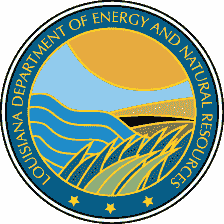Lease Sales
DNR contributes to energy savings campaign
2004 Energy Hog Campaign

Does your refrigerator go “oink, oink” every time you open it? Better beware of those prowling, loitering hogs!
Energy Hogs are on the loose in many homes across Louisiana, and these hogs are devouring energy waste resulting in higher energy bills and pollution in the environment.
The Energy Hog campaign began as a national effort in March of this year, as public service ads were distributed to radio and television stations across the state by the national Ad Council and U.S. Department of Energy. Louisiana is one of 20 states participating with partial funding for the three-year awareness project. Officials say the campaign is aimed at educating families of the benefits of saving residential energy.
The Louisiana Department of Natural Resources (DNR) joins the U.S. Department of Energy, Energy Outreach Colorado, The Home Depot, the North American Insulation Manufacturers Association, and the National Fuel Funds Network as sponsors.
The Ad Council, which invented “Smokey the Bear” and the “Just Say No to Drugs” campaigns, created the concept in 2001 in collaboration with Energy Outreach Colorado over concerns for the steady rise in natural gas prices.
"The Ad Council has a history of successfully changing behaviors and attitudes in America,” said Peggy Conlon, president and CEO of the Ad Council. “Responsible energy use is critical to our nation’s future and security. We will use our resources to bring this important message to children to take home to their parents and encourage all Americans to conserve energy,” she said.
Tangular Williams, DNR Energy Program Supervisor, said the department has funded the project over three years at a cost of $10,000. DNR operates the state’s Energy Office and promotes energy conservation through various programs managed by the department.
The campaign is aimed at children ages 8-13 in the first and third year while parents with other adults will be targeted with “energy-saving” messages in 2004 and 2005. The campaign is centered on cartoon characters (hogs) that eat-away all the energy waste in people’s homes. Williams said that classroom teachers are also encouraged to work and use the website that has been developed specifically to interest young students.
The website, www.energyhog.org, empowers kids to show their parents how to save energy by playing five online interactive games.
For example, in the Floorplan game, an Energy Hog was found feeding off the poor insulation in the attic. However, he soon starved and had to move to another house because the game allowed the player to roll insulation in the attic. Thus, the home becomes energy-efficient, and the hog moves on to feed somewhere else.
The primary benefits in saving energy are saving money on monthly energy bills and creating less pollution because fewer fossil fuels will be burned to make energy.
The website also has a downloadable “scavenger hunt” form that is a checklist to quantify a home’s energy rating. The kids can print this form and use their newfound knowledge of energy conservation to investigate their house along with their parents for energy waste.
Did You Know These Energy Facts
The following is a short list on why conserving energy is crucial for the future of this country:
- Over the next 20 years U.S. natural gas consumption will increase by 50% and electricity by 45%. (U.S. DOE National Energy Policy)
- The average household in the U.S. spent $1,481 a year on energy in 1993. (Energy Information Administration)
- To meet projected demand over the next 20 years, America must build between 1,300 and 1,900 new electric plants. (U.S. Department of Energy National Energy Policy)
- Modest increases in energy efficiency would eliminate the need for 600 new power plants, according to the Department of Energy.
- ENERGY STAR lighting uses 66% less energy than standard lighting. (ENERGY STAR,www.energystar.gov.
- Average home produces twice as much greenhouse gas pollution as the average car. (Alliance to Save Energy; www.ase.org)
Here are five easy tips according to the www.entergy.com Web site to live by while managing your energy at home:
- Seal the duct work
- Install energy-efficient light bulbs
- Add attic insulation
- Wrap your water heater
- Seal other air leaks
